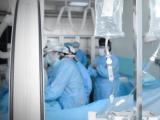Nine healthcare workers are among the 39 MERS-CoV patients identified in a hospital-based outbreak of the virus in Wadi ad-Dawasir, Saudi Arabia, and according to the World Health Organization's (WHO) technical lead, and the outbreak features both human-to-human transmission patterns and spread from animals.
Maria Van Kerkhove, PhD, the WHO's technical lead for MERS-CoV (Middle East respiratory syndrome coronavirus), told CIDRAP News there have been two amplification events in the Wadi ad-Dawasir outbreak.
One occurred in the emergency department. Because of delays in suspicion and detection of MERS-CoV with the initial patient, the virus spread to other patients, healthcare workers, and household contacts.
One of those patients then transmitted the disease to other health workers, intensive care unit patients, and household contacts.
According to Van Kerkhove, five hospitals in the region have treated patients in the Wadi ad-Dawasir cluster, but human-to-human transmission occurred at only one.
"The occurrence of this nosocomial transmission is deeply concerning. However, the epidemiologic patterns are not unusual and there are no signs so far that suggest further propagation of the outbreak," the WHO said in an update today on the 39 cases.
To complicate the outbreak, several of the primary patients identified in Wadi ad-Dawasir have been linked to contact with camels, Van Kerkhove said. Full-genome sequencing is under way to try to distinguish zoonotic transmission from those associated with human-to-human transmission, she said.
"I am hopeful the results of the sequencing will provide us with some clues to these questions," Van Kerkhove said.
Outbreak similar to other events
Van Kerkhove said transmission patterns in the Wadi ad-Dawasir cluster fit those seen repeatedly in healthcare-related outbreaks involving the virus.
Healthcare spread is linked to late detection and low suspicion of MERS, aerosolizing procedures, and close patient care with inadequate infection prevention and control (IPC) precautions, she said, adding that Saudi Arabia has initiated several measures, including a visual respiratory triaging system and training and retraining healthcare staff.
There are still too many unanswered questions about how the virus spreads in healthcare settings, and more detailed studies are needed to better understand specific risk factors for infection in hospital settings, Van Kerkhove said.
"We need more comprehensive hospital outbreak investigations, to understand how people are infected and the potential role of asymptomatic transmission. We know adequate IPC—standard, droplet, airborne precautions—can prevent transmission," she said. "The key is to use these precautions appropriately for all patients at all times."
New case in Medina
Today the Saudi Arabian Ministry of Health (MOH) reported one new case of MERS in a patient from Medina. A 64-year-old man contracted the virus after camel contact, and he is hospitalized for his infection.
The new case raises the total number of MERS cases reported in Saudi Arabia so far this year to 81. According to the WHO, from 2012 through 13 February 2019, a total of 2,345 laboratory-confirmed cases of MERS-CoV, along with 817 associated deaths, have been reported globally.
Fifty-one of those 2019 cases have been reported in Wadi-ad-Dawasir, the MOH has noted, meaning today's WHO update does not include the 12 most recent cases there.
In Saudi Arabia, small clusters with some secondary transmission are usually stopped very quickly by medical staff and support from the ministry of health.
"High-threat respiratory pathogens like MERS requires the highest level of vigilance to prevent outbreaks," Van Kerkhove said.
See also:
Feb 26 WHO update
Feb 26 MOH report






















